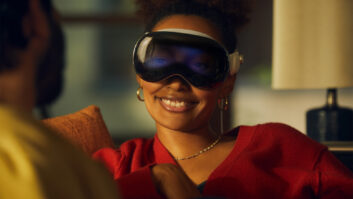Following director James Cameron’s insistence at NAB that 3D was the way forward for cinema, interest in the previously moribund medium has been high, writes Andy Stout. But with Dolby now announcing a new system to compete with the already established Real D, another potentially divisive format war is on the cards.
On Monday, Dolby announced that it has teamed up with German virtual reality company, Infitec GmbH, to develop a three-dimensional cinema projection system. The plan is to integrate Infitec’s 3D technology, originally developed by Daimler Chrysler for automotive design, with its own digital cinema playback system.
The stakes are high. The major studios are banking on technologies such as 3D to maintain audiences against the threat of DVD and increasingly capable home cinema systems Last week’s 3D debut of Columbia Pictures’ animated movie “Monster House” took more than twice the average per-screen box office of the 2D version, indicating that 3D systems can definitely boost a movie’s appeal (though this is largely untried beyond the realm of CG animation).
Dolby says its Infitec-based system will be cheaper and more flexible than that of the leading 3D incumbent, Real D, because it allows a 3D image to be projected directly onto standard white screens. Real D’s system, while it uses, passive, disposable glasses and a single digital projector, requires silver screens to boost light on the image. Existing 3D systems that use white screens also require cinema-goers to wear expensive, battery-charged – and thus heavy – glasses with mechanically driven shutters to view a 3D image. Dolby says that its method will allow audiences to use the same sort of inexpensive polarised plastic glasses used by the Real D systems.
Tim Partridge, senior vice president and general manager of Dolby’s professional division, said the company got serious about designing its own 3D system during the debut of “Chicken Little” last year. Then, Dolby worked with Disney and Real D to convert 100 theatres worldwide in approximately 100 days to digital 3D for the film’s run last autumn (Real D now claims 200+ screens).
“During that roll out we were able to see what an impact 3D had on the experience,” Partridge said. “We learned about the drawbacks. We stood back and tried to figure out what it would take to have an optimised 3D system.”
Dolby has so far deployed its digital playback system on 160 movie screens worldwide and expects its 3D technology to be available by spring of 2007. Currently, the way films are mastered will be different for each system, though Dolby is hoping to help shape a digital SMPTE 3D standard that can work on both systems.




